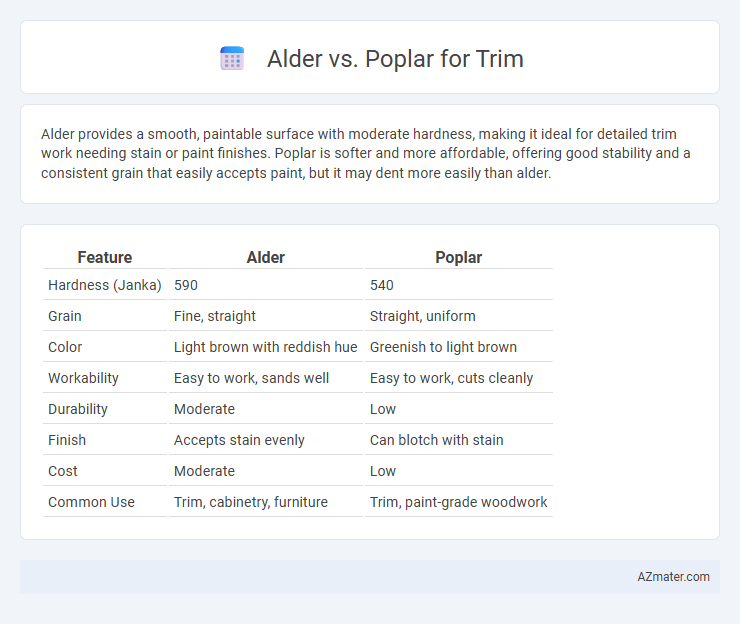Alder provides a smooth, paintable surface with moderate hardness, making it ideal for detailed trim work needing stain or paint finishes. Poplar is softer and more affordable, offering good stability and a consistent grain that easily accepts paint, but it may dent more easily than alder.
Table of Comparison
| Feature | Alder | Poplar |
|---|---|---|
| Hardness (Janka) | 590 | 540 |
| Grain | Fine, straight | Straight, uniform |
| Color | Light brown with reddish hue | Greenish to light brown |
| Workability | Easy to work, sands well | Easy to work, cuts cleanly |
| Durability | Moderate | Low |
| Finish | Accepts stain evenly | Can blotch with stain |
| Cost | Moderate | Low |
| Common Use | Trim, cabinetry, furniture | Trim, paint-grade woodwork |
Overview: Alder vs Poplar for Trim
Alder wood is valued for its fine grain and smooth texture, making it ideal for detailed trim work and staining to a rich, warm finish. Poplar, although less visually striking due to its pale color and occasional greenish hues, offers excellent workability and is often chosen for painted trim because it holds paint well and is affordable. Both species provide lightweight, stable options but Alder generally commands a higher price point while Poplar remains a budget-friendly choice for versatile trim applications.
Appearance and Grain Differences
Alder trim features a fine, straight grain with a uniform texture and a light brown to reddish color, offering a smooth and consistent appearance ideal for traditional and rustic styles. Poplar trim typically has a more uneven grain pattern with occasional knots, exhibiting a pale yellow to greenish hue that can vary significantly, making it less uniform but versatile for painted finishes. The subtle grain of alder provides a warmer, more natural wood look, while poplar's inconsistent grain and coloration suit projects where paint coverage hides imperfections.
Durability and Hardness Comparison
Alder trim offers moderate durability and a Janka hardness rating of about 590, making it softer and more prone to dents and scratches compared to Poplar. Poplar trim, with a higher Janka hardness around 540-580, provides slightly better resistance to wear but still remains relatively soft among hardwoods. For applications requiring increased durability and hardness, Poplar is generally preferred over Alder, especially in high-traffic areas or where impact resistance is important.
Workability: Cutting and Shaping
Alder offers superior workability for trim applications due to its soft, straight-grained texture, making cutting and shaping effortless with hand and power tools. Poplar is also easy to work with, but its slightly harder density can cause minor wear on blades and requires a bit more effort for detailed shaping. Both woods accept finishes well, but alder's consistent grain pattern ensures cleaner edges and smoother surfaces during the trimming process.
Finishing: Staining and Painting Results
Alder wood offers a smooth, consistent grain that readily accepts stains, producing a rich, warm finish ideal for enhancing natural wood tones in trim projects. Poplar features a more uneven grain and natural color variations, which can cause blotchy staining but responds well to solid-color paints for a uniform look. Both woods perform well with paint, but alder's superior stain absorption makes it preferable for stained trim applications.
Cost and Availability
Alder trim offers a mid-range cost that balances affordability and quality, making it a popular choice for budget-conscious projects. Poplar trim is generally less expensive and widely available in most lumber suppliers across the United States, enhancing its appeal for large-scale or cost-sensitive installations. Both woods provide good workability and consistent availability, but poplar's lower price point often drives its selection over alder in trim applications.
Suitability for Interior and Exterior Trim
Alder wood offers a smooth texture and consistent grain, making it ideal for interior trim where a refined finish and easy staining are desired, especially in cabinetry and moldings. Poplar, known for its lightweight property and moderate hardness, suits interior trim applications well due to its affordability and ease of painting, but it lacks the natural durability required for exterior use. Neither alder nor poplar is recommended for exterior trim without proper sealing and maintenance, as both woods have limited resistance to moisture and decay compared to more durable species like cedar or redwood.
Resistance to Warping and Damage
Alder wood offers moderate resistance to warping and damage, making it a reliable choice for trim in stable indoor environments. Poplar is softer and more prone to dents and warping, especially in areas with fluctuating humidity or impact exposure. Choosing alder over poplar improves the durability and dimensional stability of trim, reducing maintenance needs over time.
Best Applications for Alder Trim
Alder trim is ideal for interior applications such as cabinetry, moldings, and window casings due to its smooth grain and ability to take stain evenly, offering a warm and uniform finish. It performs exceptionally well in spaces requiring a rustic or traditional aesthetic, as the wood's softness allows for easy machining and detailed carving. Compared to poplar, alder provides a more attractive natural grain and greater durability, making it the preferred choice for high-visibility trim projects.
Best Uses for Poplar Trim
Poplar trim is ideal for painted finishes due to its smooth texture and consistent grain, making it a cost-effective choice for interior trim applications like baseboards, window casings, and door frames. Its lightweight nature and ease of machining allow for intricate molding designs without warping or splitting. Poplar's versatility also extends to DIY projects and furniture, but it is less suitable for staining compared to alder, which highlights natural wood grain better.

Infographic: Alder vs Poplar for Trim
 azmater.com
azmater.com